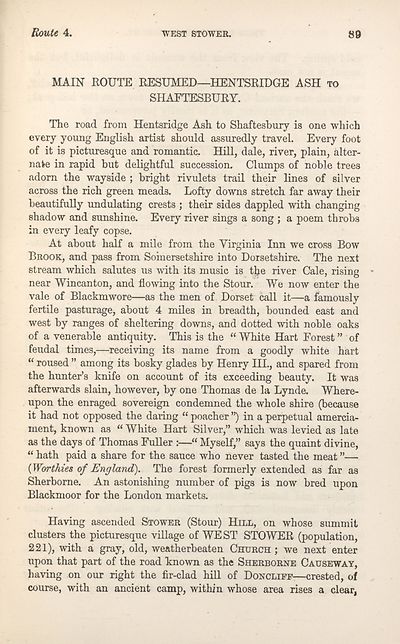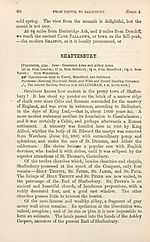Download files
Complete book:
Individual page:
Thumbnail gallery: Grid view | List view

Route 4.
WEST STOWER.
89
MAIN ROUTE RESUMED—HENTSRIDGE ASH to
SHAFTESBURY.
The road from Hentsridge Ash to Shaftesbury is one which
every young English artist should assuredly travel. Every foot
of it is picturesque and romantic. Hill, dale, river, plain, alter¬
nate in rapid but delightful succession. Clumps of noble trees
adorn the wayside ; bright rivulets trail their lines of silver
across the rich green meads. Lofty downs stretch far away their
beautifully undulating crests ; their sides dappled with changing
shadow and sunshine. Every river sings a song ; a poem throbs
in every leafy copse.
At about half a mile from the Virginia Inn we cross Bow
Brook, and pass from Somersetshire into Dorsetshire. The next
stream which salutes us with its music is tlje river Gale, rising
near Wincanton, and flowing into the Stour. We now enter the
vale of Blackmwore—as the men of Dorset call it—a famously
fertile pasturage, about 4 miles in breadth, bounded east and
west by ranges of sheltering downs, and dotted with noble oaks
of a venerable antiquity. This is the “ White Hart Forest ” of
feudal times,—^receiving its name from a goodly white hart
“ roused ” among its bosky glades by Henry III., and spared from
the hunter’s knife on account of its exceeding beauty. It was
afterwards slain, however, by one Thomas de la Lynde. Where¬
upon the enraged sovereign condemned the whole shire (because
it had not opposed the daring “ poacher ”) in a perpetual amercia¬
ment, known as “ White Hart Silver,” which was levied as late
as the days of Thomas Fuller :—“ Myself,” says the quaint divine,
“ hath paid a share for the sauce who never tasted the meat ”—
{Worthies of England). The forest formerly extended as far as
Sherborne. An astonishing number of pigs is now bred upon
Blackmoor for the London markets.
Having ascended Stower (Stour) Hill, on whose summit
clusters the picturesque village of WEST STOWER (population,
221), with a gray, old, weatherbeaten Church ; we next enter
upon that part of the road known as the Sherborne Causeway,
having on our right the fir-clad hill of Doncliff-—crested, of
course, with an ancient camp, within whose area rises a clear,
WEST STOWER.
89
MAIN ROUTE RESUMED—HENTSRIDGE ASH to
SHAFTESBURY.
The road from Hentsridge Ash to Shaftesbury is one which
every young English artist should assuredly travel. Every foot
of it is picturesque and romantic. Hill, dale, river, plain, alter¬
nate in rapid but delightful succession. Clumps of noble trees
adorn the wayside ; bright rivulets trail their lines of silver
across the rich green meads. Lofty downs stretch far away their
beautifully undulating crests ; their sides dappled with changing
shadow and sunshine. Every river sings a song ; a poem throbs
in every leafy copse.
At about half a mile from the Virginia Inn we cross Bow
Brook, and pass from Somersetshire into Dorsetshire. The next
stream which salutes us with its music is tlje river Gale, rising
near Wincanton, and flowing into the Stour. We now enter the
vale of Blackmwore—as the men of Dorset call it—a famously
fertile pasturage, about 4 miles in breadth, bounded east and
west by ranges of sheltering downs, and dotted with noble oaks
of a venerable antiquity. This is the “ White Hart Forest ” of
feudal times,—^receiving its name from a goodly white hart
“ roused ” among its bosky glades by Henry III., and spared from
the hunter’s knife on account of its exceeding beauty. It was
afterwards slain, however, by one Thomas de la Lynde. Where¬
upon the enraged sovereign condemned the whole shire (because
it had not opposed the daring “ poacher ”) in a perpetual amercia¬
ment, known as “ White Hart Silver,” which was levied as late
as the days of Thomas Fuller :—“ Myself,” says the quaint divine,
“ hath paid a share for the sauce who never tasted the meat ”—
{Worthies of England). The forest formerly extended as far as
Sherborne. An astonishing number of pigs is now bred upon
Blackmoor for the London markets.
Having ascended Stower (Stour) Hill, on whose summit
clusters the picturesque village of WEST STOWER (population,
221), with a gray, old, weatherbeaten Church ; we next enter
upon that part of the road known as the Sherborne Causeway,
having on our right the fir-clad hill of Doncliff-—crested, of
course, with an ancient camp, within whose area rises a clear,
Set display mode to:
![]() Universal Viewer |
Universal Viewer | ![]() Mirador |
Large image | Transcription
Mirador |
Large image | Transcription
| Antiquarian books of Scotland > Adventure and adventurers > Black's guide to the counties of Dorset, Devon, & Cornwall > (111) |
|---|
| Permanent URL | https://digital.nls.uk/142587710 |
|---|
| Description | Thousands of printed books from the Antiquarian Books of Scotland collection which dates from 1641 to the 1980s. The collection consists of 14,800 books which were published in Scotland or have a Scottish connection, e.g. through the author, printer or owner. Subjects covered include sport, education, diseases, adventure, occupations, Jacobites, politics and religion. Among the 29 languages represented are English, Gaelic, Italian, French, Russian and Swedish. |
|---|

